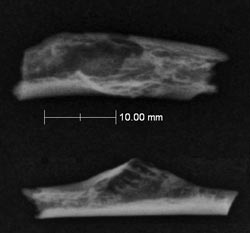Earliest Evidence of Cancer Discovered in Hominid Fossil Record
With a report out today from Macmillan Cancer Support stating that by 2020 nearly half the population of the United Kingdom will get cancer during their lifetime, scientists from the University of Kansas have been looking at the oldest incidence of hominid cancer yet found in the fossil record. Many types of cancers today are associated with a diet which contains too much fat, or exposure to pollution, radiation or other toxins. However, a fragment of rib bone found in a cave in Krapina, Croatia shows evidence of a fibrous dysplasia (bone cancer) in a Neanderthal.
Neanderthal Rib Bone
Finding evidence of pathology is rare in the human fossil record. Something such as a fleshy tumour would not be preserved as a fossil, but the evidence of a tumour can be seen as it has affected the internal structure of the rib bone. The rib specimen is believed to date from around 120,000 years ago, a paper on its discovery and its implications has been published in the on line, peer reviewed journal, PLoS One (public library of science).
A Picture of the Diseased Bone (Top) Compared to Healthy Neanderthal Bone (Bottom)
Picture credit: University of Kansas
Neanderthals Suffered Tumours
Professor of Anthropology at the University of Kansas, David Frayer, one of the co-authors of the scientific paper commented:
“It’s evidence that Neanderthals suffered tumours — that they were susceptible to the same kinds of diseases that we see in modern humans. Before this, the earliest tumour in bone that we’ve seen goes back to an Egyptian mummy. So this is 100,000 years older[at least] than the previous tumour that has been found. There is no evidence of cancer older than this in the human fossil record.”
The bone fragment is one of over 900 different hominid bones which have been found in the cave, along with other items such as stone tools. The bone is not associated with a complete skeleton so it is impossible to say how severe the cancer was, or indeed whether or not it was the cause of death. Researcher are not able to identify whether the bone comes from a male or female. It does suggest that even in a pristine environment cancers were still present.
Our closest Relative
The Neanderthal (H. neanderthalis), is believed to be our closest relative, we share a common ancestor with the Neanderthals and in recent years study of both the Neanderthal and H. sapiens genome show that most people possess about 4 percent of Neanderthal genes in their genetic make up.
Neanderthals were short, stocky and heavily muscled. Evidence of the heavy musculature appears in the extremely large muscle attachment scars on the fossil bones and the bowing of some of the limb bones. Neanderthals were tough, used to hard physical work and suffered many injuries, although contrary to popular opinion they were not the brutish apemen often depicted in the early 20th Century. They had large brains, were very well adapted to life in a cold climate and they made sophisticated stone tools.
Radiographs and CT Scans
According to the researchers, the Neanderthal bone is a 30-millimetre-long fragment of the left rib that shows a fresh break. The break in the rib exposes a chamber that is 18 millimetres in length and 7.6 millimetres wide. This cavity in the bone is highly unusual — ordinarily a rib is packed with cancellous bone. After a detailed analysis with radiographs and CT scans, the investigators came to believe it was the site of a benign tumour associated with a bone cancer.
Fibrous dysplasia (bone cancer), is a developmental disorder of bone in which lesions develop fibrous tissue and spicules of woven bone. However, it’s difficult to know for certain how severely the tumour affected the Neanderthal involved.
Detailed Analysis of the Bone Fragment Revealed the Pathology
Picture credit: University of Kansas
Professor Frayer added:
“It wasn’t a small tumour. It was a fairly large one, probably bulging at the base of the rib. We’re not sure how far along it was, but it was well-expressed in the bone. It was in the upper third of the back, and muscles attach there that are associated with raising the arm.”
This discovery will help scientists to understand a little more about how cancers could have affected our ancestors. It also demonstrates that cancer is not a modern phenomenon and that although rare in the fossil record, it provides a clue to the complicated relationship between early humans and forms of cancer.







Wow. That is so elegant and logical and clearly explained. keep it up! I’ll go ahead and bookmark your website to come back later.